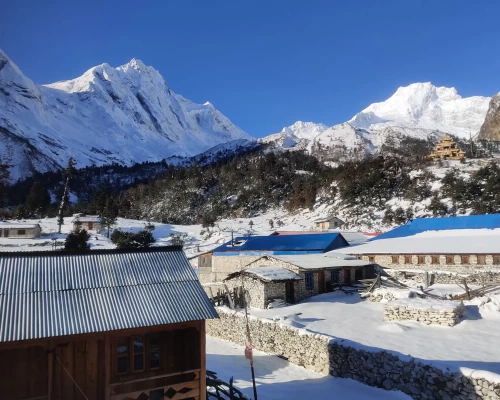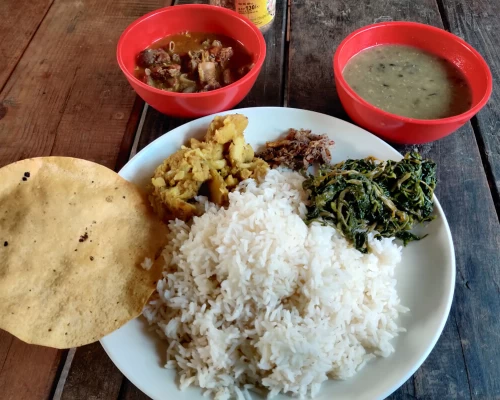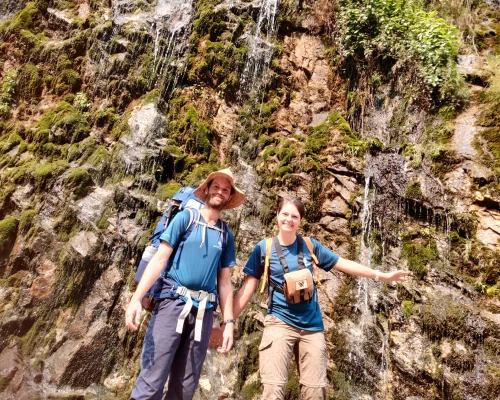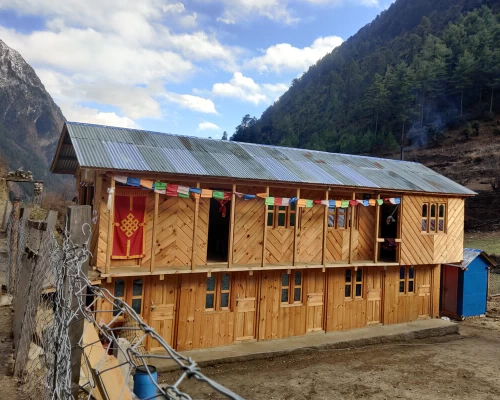How is the trek to Manaslu?
The Manaslu Best Itinerary Trek is a trek designed by us, Nature Excursions, with the sole motive of providing a comprehensive experience of the entire Manaslu Trek through our package. Manaslu is an amazing trek overall, and we have endeavored to gather all the alluring aspects of the Manaslu trek within this package. The package starts with a drive to Machhikhola, taking you to famous places such as Pyungen Gompa and Birendra Lake and all the way through the Thorongla Pass before bringing you back to Kathmandu. Throughout the trek, most of the places in the Manaslu region are covered, allowing you to enjoy your journey to the fullest.
How is the overall Manaslu Trek?
The Manaslu region is unlike other treks in the sense that the trek is not crowded and packed with visitors. However, the magnificent places you get to visit via the trek are noteworthy. The Manaslu region offers a variety of trekking options. The popular Manaslu trekking route of 177 kilometers (110 mi) skirts the Manaslu massif over the pass down to Annapurna. The Manaslu Circuit Trek is a picturesque and undoubtedly off-beaten journey in Nepal. It is probably the most underrated trekking route and one of the most popular restricted treks in the Manaslu Region of Nepal. We can surely say that the best itinerary trek to Manaslu Circuit Trek features everything you'd want from a classic trek in Nepal: epic scenery, intimate encounters with local people and their ancient culture, and a 17,000-foot (5,100 m) Himalayan pass crossing.
What food and accommodation options will be available for the best Manaslu Trek?
The main accommodations for the trail are teahouses and lodges. Teahouses are the most common type of accommodation along the trail, usually located in villages or on the main trekking trails. Lodges are larger and more comfortable than teahouses, but they also tend to be more expensive. Lodges often have private bathrooms, hot showers, and Western food options. In lower-altitude areas like Machha Khola, Jagat, Deng, and Namrung, travelers can find excellent dining options. Especially during peak seasons, these establishments often employ skilled chefs to cater to their guests. The restaurants typically offer a variety of cuisines, including Nepalese, Tibetan, Indian, and Continental dishes, ensuring that visitors have a diverse range of dining choices to enjoy during their stay. In the elevated regions like Lho Gaun, Samagaon, Samdo, and Dharmashala, you won't find fancy restaurants, but the locals offer delicious homemade meals. Women in local households possess the essential culinary skills to prepare authentic Nepalese dishes, reflecting their rich cultural heritage. Travelers can enjoy hearty and flavorful meals prepared with care and tradition by these skilled local cooks, providing a genuine taste of the region's cuisine amidst its stunning landscapes.
Are there risks associated with altitude sickness during the trek to the Manaslu region?
Altitude sickness is indeed a significant concern for trekkers in the Manaslu region. The Manaslu Circuit Trek starts at an elevation of around 700 meters in Macchi Khola and reaches its highest point at Thorong-La Pass. This substantial change in altitude over a relatively short period can lead to altitude sickness, as the body may not have sufficient time to acclimate to the decreasing oxygen levels.
Altitude sickness typically starts to occur around 3,000 meters, though some individuals may be affected at lower altitudes. Symptoms may include headaches, vomiting, tiredness, confusion, trouble sleeping, and dizziness. More severe forms of altitude sickness include high-altitude pulmonary edema (HAPE) and high-altitude cerebral edema (HACE), both of which can be life-threatening.
The risk of altitude sickness on the Manaslu Circuit Trek is managed through careful itinerary planning, which we have done in this package. We plan our trip so that it allows for gradual acculturation. This includes rest days and slow ascents to give the body time to adjust to the lower oxygen levels at higher altitudes. Despite these precautions, some of you may have difficulties with acclimatization. However, at Nature Excursion, we make sure you have the best experience and have a backup plan in case you do get sick.
To avoid altitude sickness during the trek, do the following things:
- Drink plenty of water.
- Do not smoke or drink alcoholic drinks.
- Take plenty of rest and eat nutritious food.
- Maintain your pace.
What are the alternative routes or passes near the Manaslu trek?
Attracting hikers with its pristine habitat and breathtaking views, the Manaslu Trek provides a one-of-a-kind Himalayan journey. There are fewer well-known paths and mountain passes that can be explored in addition to the well-known conventional route to Annapurna Base Camp, which is renowned for its rough beauty. For those seeking direction, we provide these alternate paths, each offering a unique perspective and engaging experiences. Hikers may explore more of the Manaslu region, including less-visited settlements, contrasting scenery, and cultural treasures, by deviating from the beaten path. Explore the breathtaking Manaslu region on foot with these alternative paths that will take your trekking trip to new heights.
The best alternative routes for an itinerary are as follows: The Manaslu Trek can be the Trek to Annapurna round trip where you can explore the enchanting Annapurna region with the view of the Annapurna range, Dhaulagiri, Machhapuchre, Gangapurna, and many more. For a really short trek, you can check out the Ghorepani Ghandruk Short Trek, which you can do for a quick trek in the Annapurna region.
How do I prepare for the Manaslu Trek?
As you prepare for the Manaslu Circuit trek, it's crucial to understand that you'll be embarking on a challenging journey that will test your physical limits. This trek demands that you carry your gear throughout the entire trail, covering a distance of approximately 177 kilometers (109.98 miles) while crossing elevations exceeding 5,000 meters. To tackle this arduous adventure successfully, you must train your body through a comprehensive regimen of strength and endurance training, elevation training, and aerobic conditioning.
Strength and endurance training is essential, as it will prepare your muscles to endure the strain of carrying a significant load for extended periods of time. This type of training involves performing more repetitions with lighter weights compared to traditional strength training. By incorporating this into your routine, you'll build the necessary muscular endurance to navigate the demanding terrain of the perfect itinerary, the Manaslu Circuit. Additionally, elevation training is vital to acclimatizing your body to the high altitudes you'll encounter during the trek. Incorporate incline workouts, such as hiking uphill or using a stair climber, into your regimen, gradually increasing the intensity and duration as you progress. This will help your body adapt to the reduced oxygen levels at higher elevations, minimizing the risk of altitude sickness. Aerobic conditioning is equally important, as it will enhance your cardiovascular endurance, enabling you to sustain prolonged physical exertion. Activities like jogging, cycling, or swimming will strengthen your respiratory system and improve your overall stamina, allowing you to cover challenging distances with greater ease.
Given the demanding nature of the ideal itinerary for the Manaslu Circuit trek, it is advisable to start your preparation at least a couple of months before your journey. In the month leading up to the adventure, prioritize dedicating one to two hours of daily jogging at home. This practice will fortify your calves, enhance ankle flexibility, and provide the necessary strength and endurance to navigate the rugged terrain successfully.
What will be the best season and time to undertake the trek to Manaslu and Sama Gaun?
There are four main seasons in Nepal. If you are planning to go on a trek to the Manaslu circuit in 2024 and 2025, it is undoubtedly the best decision of your life, and here is a comprehensive insight into how each time of the year looks en route to the Manaslu region trek.
Trekking the Manaslu Circuit in Winter (December–February)
The winter months on the Manaslu Circuit bring cold air and frequent snowfall along with it, adding an extra layer of challenge to the already demanding Manaslu Circuit Trek. During this time, you can expect the landscapes to be blanketed in snow, including the nearby peaks of Manaslu, Himalchuli, and Ngadi Chuli. However, the trails can be more difficult due to snow, and the tea houses along the route may have limited facilities and reduced prices for accommodation and food.
Spring on the Manaslu Circuit (March–May)
Spring is considered an ideal time for first-time trekkers to go on the best itinerary, the Manaslu Circuit Trek. The weather during these months is relatively stable and calm, with clear skies providing unobstructed views of the surrounding peaks. The region comes alive with vibrant blooms, including the national flower of Nepal and rhododendrons, adding to the natural beauty of the diverse landscapes you'll encounter along the way.
Summer on the Manaslu Circuit (June–August)
The summer months in Nepal coincide with the monsoon season, which brings heavy rainfall to the Manaslu region. While trekking during this time is possible, it can be challenging due to muddy trails, swollen rivers, and an increased risk of landslides. Additionally, the surrounding views may be obscured by clouds and mist, and leeches thrive during this season of monsoon in the Manaslu Circuit.
Autumn on the Manaslu Circuit (September–November)
Autumn is widely regarded as the prime trekking season in Nepal, including for the Manaslu Circuit Trek. During this time, mountaineers from all around the world flock to the region to summit some of the highest peaks, such as Manaslu (8,163m) and Himalchuli (7,893m). The weather is generally stable, with clear skies and moderate temperatures, making it an ideal time to get on this challenging trek. The landscapes are vibrant, and the views of the surrounding peaks are simply stunning.







.webp)


